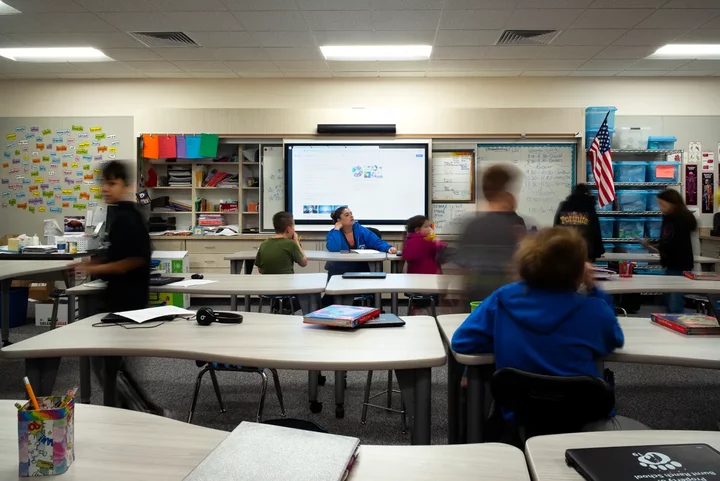A new classroom at Burnt Ranch Elementary School in Trinity County on Dec. 13, 2019. Photo by Dave Woody for CalMatters
As lawmakers finalize a school facilities bond for the November ballot, some superintendents from low-income and small districts say the proposal leaves them with an all-too-familiar feeling: underfunded and overlooked.
“Am I mad? Yeah, I am very mad,” said Gudiel Crosthwaite, superintendent of Lynwood Unified, in a low-income area in Los Angeles County. “California has a responsibility to educate its children, regardless of where they live. This bond favors larger, higher-wealth districts at the expense of districts like ours.”
Lawmakers struck a deal late Saturday night on Assembly Bill 247, a $10 billion bond that would pay for repairs and upgrades at K-12 schools and community colleges throughout the state. Schools desperately need the money: The current fund for school repairs is nearly empty and the voters rejected the state’s last school facilities bond, in 2020.
Everyone agrees on the need for money to fix dry rot and build new science labs. But some superintendents, as well as the civil rights law firm Public Advocates, had been pushing for a more equitable way to distribute the money. Currently, the state doles out facilities funding through 50-50 matching grants, which means that districts that can raise a lot of money locally — typically, higher-income areas — can get more state money.
Public Advocates has threatened to sue California if it doesn’t adopt a wider sliding scale for distributing the money. The current deal does include a sliding scale, but it’s only from 60% to 65%, not the 5% to 90% that Public Advocates wanted. Under the deal’s scale, the state’s wealthiest districts would only get slightly less than its poorest.
Also under the current proposal, schools could get more money if they hire union contractors for their construction projects. That gives an edge to urban areas where union labor is easier to find.
“California has a responsibility to educate its children, regardless of where they live. This bond favors larger, higher-wealth districts at the expense of districts like ours.”
— Gudiel Crosthwaite, superintendent, Lynwood Unified Dchool District
Brooke Patton, spokeswoman for the State Building and Trades Council of California, said hiring union workers would benefit any school project because the workers are highly trained and efficient. Union projects also include apprentices, who may be from the local community.
“Not only does California end up with new school facilities, but also a new generation of workers who can afford to live in California and contribute to our economy for years to come — a worthy investment of public funds,” Patton said.
The bill still needs to pass both houses with a two-thirds majority and be signed by the governor this week. To go into effect, it needs approval from a simple majority of voters in the fall.
‘It’s a compromise’
While the bill doesn’t satisfy every need for California’s schools, it’s better than nothing, some education advocates said this week.
“It’s not perfect; it’s a compromise,” said Derick Lennox, senior director at California County Superintendents, which represents school administrators and is supporting the bill. “(The bond) takes incremental, important steps toward equity that will do a lot of good.”
The bill includes some help for smaller and low-income districts, such as providing extra money to hire project managers and expanding the number of districts that qualify for hardship funds. It also sets aside 10% of the money for small districts.
The California School Boards Association is also supporting the bill, along with a companion bill, AB 2831, sponsored by Assemblymember Josh Hoover, a Republican from Folsom, that would provide more relief for small and low-income districts if the school bond passes in November.
“We’re more than sympathetic to the needs of small districts,” said association spokesperson Troy Flint. “But times are tight, and we feel it’s crucial to get a school bond on the ballot. … It’s not what we need, but it’s what we could get. Now we have to focus on getting it passed, for the health and safety of California students.”
Old heaters, outdated kitchens, no AC
Trinity County Superintendent Fabio Robles said that some of the schools in his county are so dilapidated that any money is welcome. Passing local bonds is almost impossible, he said, because the county is so poor. So schools are almost totally reliant on the state for repairs.
In Lewiston, the gym has no air conditioning and the kitchen dates from the 1950s, Robles said. At Van Duzen Elementary, a small K-8 school in the mountains, the heater is 40 years old.
“Would a 5-90% sliding scale have been better? Yes. But what’s being proposed now will be a big help to us,” Robles said. “I’ll take that any day of the week.”
In Lynwood, Superintendent Crosthwaite said he’s tired of low-income students having to put up with broken air conditioners and leaky roofs while their more affluent peers enjoy state-of-the-art facilities. His district, for example, is going to ask voters this fall to approve a bond for $80 million. Across town, Pasadena Unified is moving forward with a $900 million school facilities bond. If the state offers matching grants, Pasadena will get even more money.
“We’re more than sympathetic to the needs of small districts. But times are tight, and we feel it’s crucial to get a school bond on the ballot.”
— Troy Flint, spokesperson, California School Boards Association
Meanwhile, students in Lynwood Unified lack basic facilities, he said. A middle school only has a blacktop, no green space. An elementary school lacks hot water. The district doesn’t have enough performance spaces or science labs.
“Our kids think this is normal. It should not be ‘normal,’” Crosthwaite said. “In California we call ourselves progressive, but we need to take a hard look at how we allocate our resources.”
###
CalMatters.org is a nonprofit, nonpartisan media venture explaining California policies and politics.

CLICK TO MANAGE